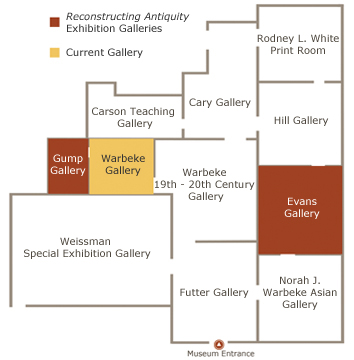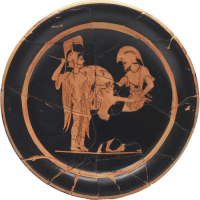The Greek hero “Lesser Ajax” abducting the Trojan princess Kassandra
Learn more about the object below
The beautiful Trojan princess Kassandra, daughter of Priam and Hecuba, is best known for her prophetic powers and for what she suffered at the hands of the "Lesser" Ajax (son of Oeleus of Locris) during the sack of Troy. The episode, sometimes referred to as the “rape of Kassandra,” is the most frequently depicted incident in her life, often found on vase-paintings of the late sixth and early fifth centuries BCE. The second-century CE "tour guide" Pausanias provides further evidence for its popularity: relief carvings on the statue of Zeus at Olympia, the chest of Cypselus at Delphi, and paintings by Polygnotus in both Athens and Delphi. None of the works he mentions, however, has survived.
The Ajax and Kassandra story appears neither in the Iliad or Odyssey, but an ancient summary of the (now lost) epic Sack of Troy provides its outline. As the Greeks swarmed Troy, Ajax forcibly dragged Kassandra, together with a statue of Athena, away from her place of refuge at the goddess's altar. Afterwards, the Greeks tried Ajax for his crime, but acquitted him when he swore his innocence at Athena’s altar. Apparently, the goddess disagreed with their decision: she arranged for the storm that killed Ajax along with many of his fellow Greeks returning from Troy.
On this Paseas plate from the Yale collection, Ajax overpowers a partially nude Kassandra as Athena (at left) towers over the two mortals—is she a statue or the goddess herself? Davreux (1942) concludes from Kassandra’s nudity in many of the surviving scenes that artists used it to suggest the sexual nature of Ajax’s crime. In this image his intent is clearly sexual. The oldest of our written sources, however, say only that Ajax “seized” or “dragged” Kassandra from the altar; not until Lycophron's poem Alexandra (3rd century BCE) is there an explicit allusion to the sexual assault of Kassandra.
Ajax need not have violated Kassandra sexually to rouse Athena's ire: use of force against a suppliant in the goddess’s precinct was itself an offense. Connelly (1993), in fact, detects a progressive shift of emphasis in these scenes, from sacrilege to sexual crime. She argues that in latter depictions, Kassandra’s increased size and exposure, together with Ajax’s depiction as a young nude warrior with eyes riveted on his prey, heightens the sexual charge. Yale’s early red-figure image features an older Ajax, wearing a helmet and grabbing a miniature Kassandra. Both Athena’s monumental size and her martial pose, with spear pointed at the warrior, emphasize Ajax's sacrilege.
Label text by Paula Debnar, Professor of Classics, Mount Holyoke College
Suggested readings:
Bethe, E. “Kassandra, Real-Encyclopädie der classischsen Altertumswissenschaft. Stuttgart, 1919 (2290–2293).
Connelly, J. B. “Narrative and Image in the Attic Vase Painting: Ajax and Kassandra at the Trojan Palladion,” Narrative and Event in Ancient Art, ed. P. J. Holliday. Cambridge, 1993 (88–129).
Davreux, J. La légende de la prophétesse Cassandre d’ après les textes et les monuments. Paris, 1942.
Mason, P. G. “Kassandra,” Journal of Hellenic Studies, vol. 79, 1959 (80–93).
Mazzoldi, S. Cassandra, la vergine e l’indovina. Identità di un personaggio da Omero all’ Ellenismo. Pisa and Rome, 2001.
Neblung, D. Die Gestalt der Kassandra in der antiken Literatur. Stuttgart and Leipzig, 1997.
Paoletti, O., “Addenda: Kassandra I,“ Lexicon Iconographicum Mythologiae Classicae (LIMC), 1994 (7.1, 956–70; 7.2, 670–85).
Touchefeu, O., “Aias II,” Lexicon Iconographicum Mythologiae Classicae (LIMC). 1981 (1.1, 336–51; 1.2, 253–70).
Ancient Sources: (note: All but Alcaeus are later than the date of the plate, although Proclus summarizes archaic poems)
Alcaeus (frag.) (6th century BCE); Sophocles, Locrian Ajax (frag.) (5th century BCE); Euripides, Trojan Women (5th century BCE); Lycophron, Alexandra (3rd century BCE); Vergil, Aeneid (1st century BCE); Hyginus, Fabulae (1st century BCE-1st century CE); (Pseudo-) Apollodorus, Library (1st century CE); Pausanias, Description of Greece (2nd century CE); Proclus, Chrestomathia (2nd century CE)


